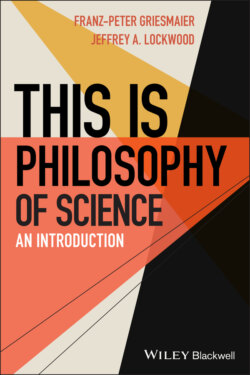Читать книгу This is Philosophy of Science - Franz-Peter Griesmaier - Страница 39
3.2.3 Ravens and White Chalk
ОглавлениеThe falsification approach has a second advantage: It solves a notorious problem that arises for Hempel’s model of confirmation, a problem of which Hempel himself was aware. The problem itself is a bit on the abstract side and will strike any working scientist as a “typical philosophical problem,” but it is worth considering at this juncture because it is both clever and troubling. Imagine that an ornithologist had spent his career studying ravens around the world. He’s seen a couple thousand of the birds, and every one has been black. So, he’s working on a paper proposing that all ravens are black, but he’s wondering what evidence he can use in addition to his observations of the birds. While lecturing in class, he looks at the chalk in his hand, stops speaking, and a big smile comes to his face. The ornithologist realizes that the white chalk supports his thesis. But how could this be?
Notice first that all ravens are black means the same as that if anything is a raven, then it is black. Thus, if it is not black, it is not a raven. In other words, all things that are not black are not ravens. Therefore, “all ravens are black” is logically equivalent to “all nonblack things are nonravens.” Now, it seems clear that if a piece of evidence confirms a hypothesis H, that same piece of evidence should also confirm all those hypotheses which are logically equivalent to H. This widely accepted principle is known as Hempel’s equivalence condition.1 Suppose we call the hypothesis “All nonblack things are nonravens” H. H must be confirmed by any nonblack thing that is not a raven. For example, a piece of white chalk will confirm H. However, since H is equivalent to “All ravens are black,” it follows that the piece of white chalk also confirms it! Let this sink in: The ornithologist’s claim that all ravens are black is confirmed by the observation of a white piece of chalk. To many, this seemed strange enough to call it paradoxical, and so the problem received its name: Hempel’s Raven Paradox.
Let us look at the paradox in explicit argument form:
1 Positive instances confirm a universal generalization, such as the generalization “All ravens are black.”
2 Logically equivalent theories are confirmed by the same evidence.
3 “All ravens are black” is logically equivalent to “All nonblack things are nonravens.”
4 A piece of white chalk is a positive instance of the generalization “All nonblack things are nonravens.”
5 Thus, from 1, it follows that a piece of white chalk confirms the generalization “All nonblack things are nonravens.”
6 Therefore, from 2, 3, and 5, it follows that a piece of white chalk confirms the generalization “All ravens are black.”
The conclusion stated on line 6 gives rise to the paradox we are worried about. What happens if we replace the confirmation approach by the falsification approach? Somewhat surprisingly, the paradox doesn’t arise. “All nonblack things are nonravens” is falsified by a nonblack thing that is a raven, which is the same as a raven that is not black. Of course, ravens that are not black also falsify the original hypothesis, “All ravens are black.” Thus, the same piece of evidence falsifies the hypothesis in both of its logically equivalent formulations. There is not a whiff of paradox here. To see this more clearly, let’s cast the falsification treatment of the “Raven Paradox” in explicit argument form as well:
1*. Negative instances falsify a universal generalization, such as the generalization “All ravens are black.”
2*. Logically equivalent theories are falsified by the same evidence.
3*. “All ravens are black” is logically equivalent to “All nonblack things are nonravens.”
4*. A nonblack raven is a negative instance of the generalization “All nonblack things are nonravens.”
5*. Thus, from 1, it follows that a nonblack raven falsifies the generalization “All nonblack things are nonravens.”
6*. Therefore, from 2, 3, and 5, it follows that a nonblack raven falsifies the generalization “All ravens are black.”
Line 6* is not paradoxical at all! On the contrary, it is exactly what we would expect on the falsificationist approach. A nonblack raven is a negative instance of the generalization “All ravens are black.” That it falsifies “All ravens are black” follows from 1*. Thus, in light of its ability to avoid the Raven Paradox, while keeping with the view that logically equivalent theories should be evaluated the same in light of the same evidence, the falsificationist approach seems preferable over the confirmation approach to theory acceptance. Again, for the falsificationist, we should accept a theory as long as it hasn’t been falsified, despite rigorous testing. Tests on this view should only be used to rid science of false theories; they are useless for showing that a theory is likely to be true because a test revealed a positive instance.
It might be tempting to regard the falsificationist treatment of Hempel’s Raven Paradox as a decisive victory for Popper’s approach. It apparently can honor the idea that logically equivalent theories should be treated the same by the same evidence without leading to a paradox. Hempel’s confirmation approach, in contrast, leads to a paradox. However, there are also serious problems besetting Popper’s approach. To see this, let’s return to the spherical earth example from earlier.
